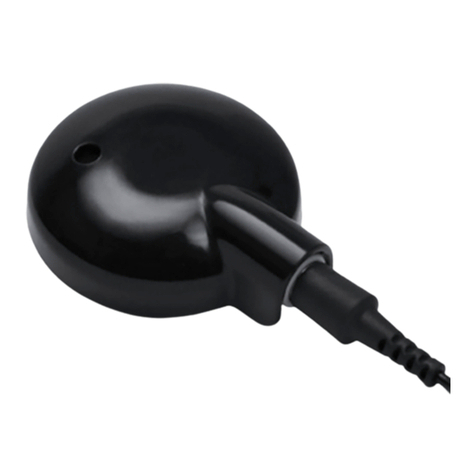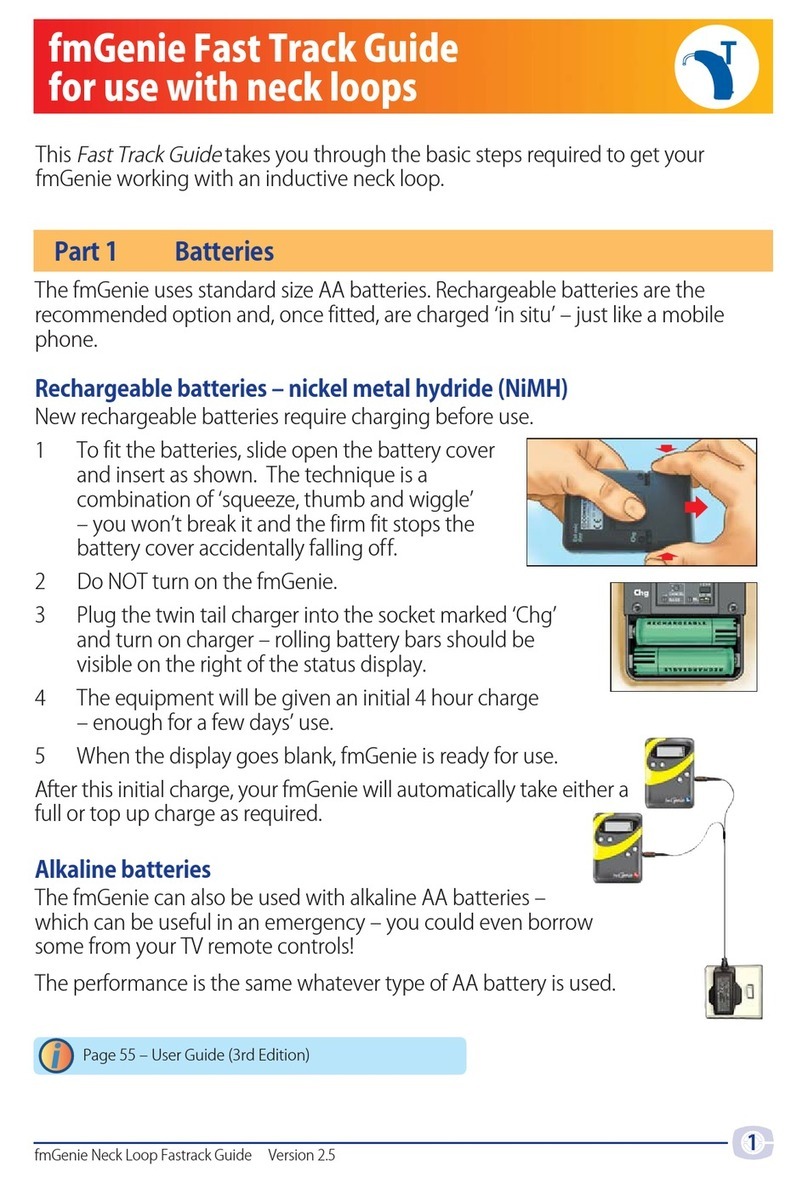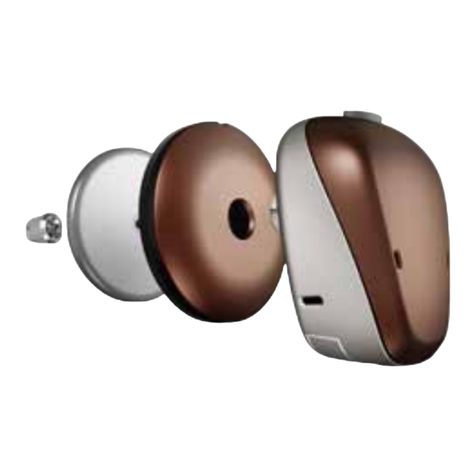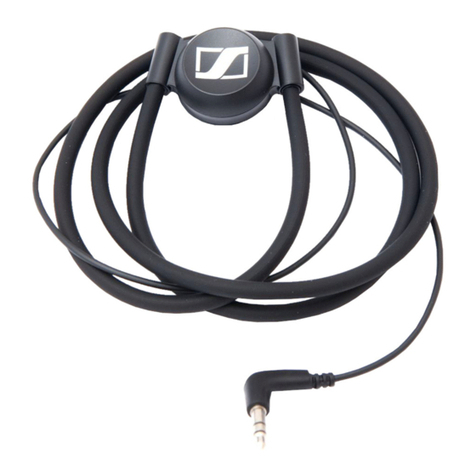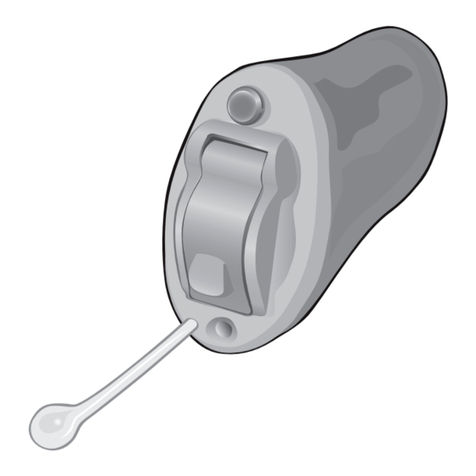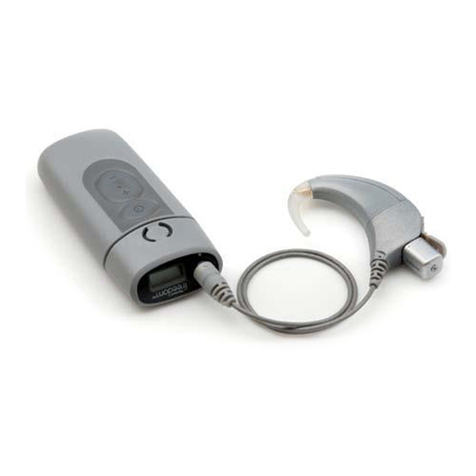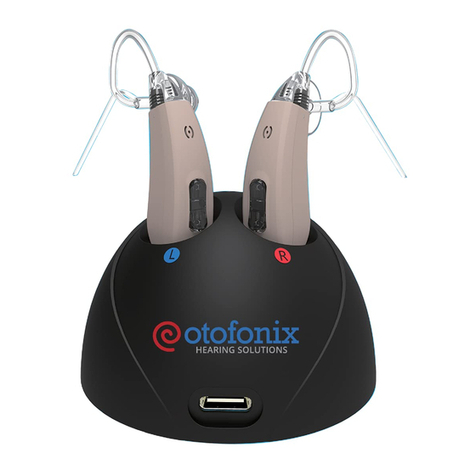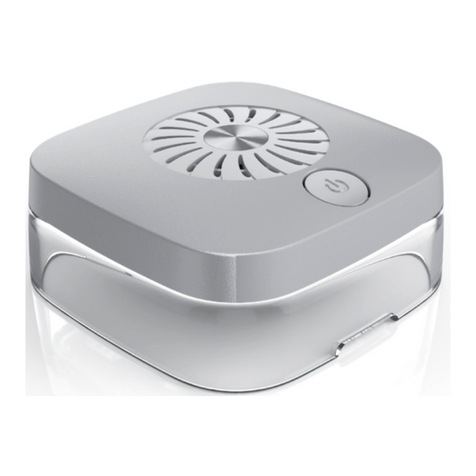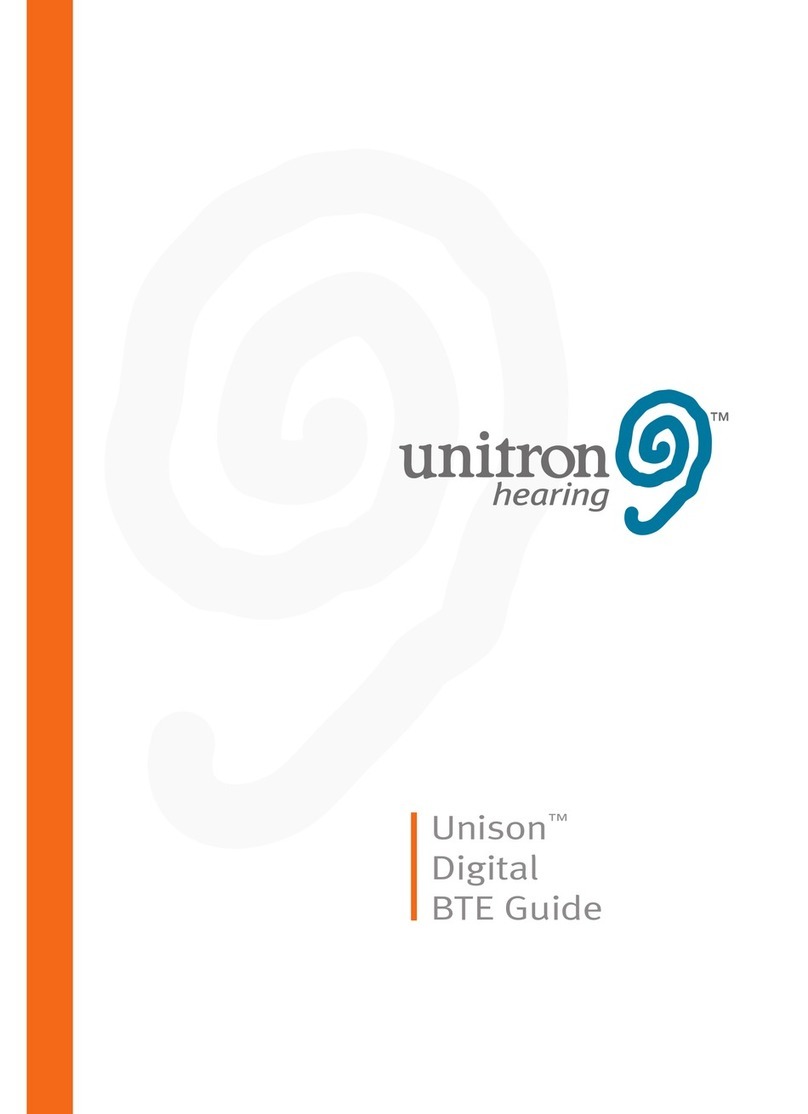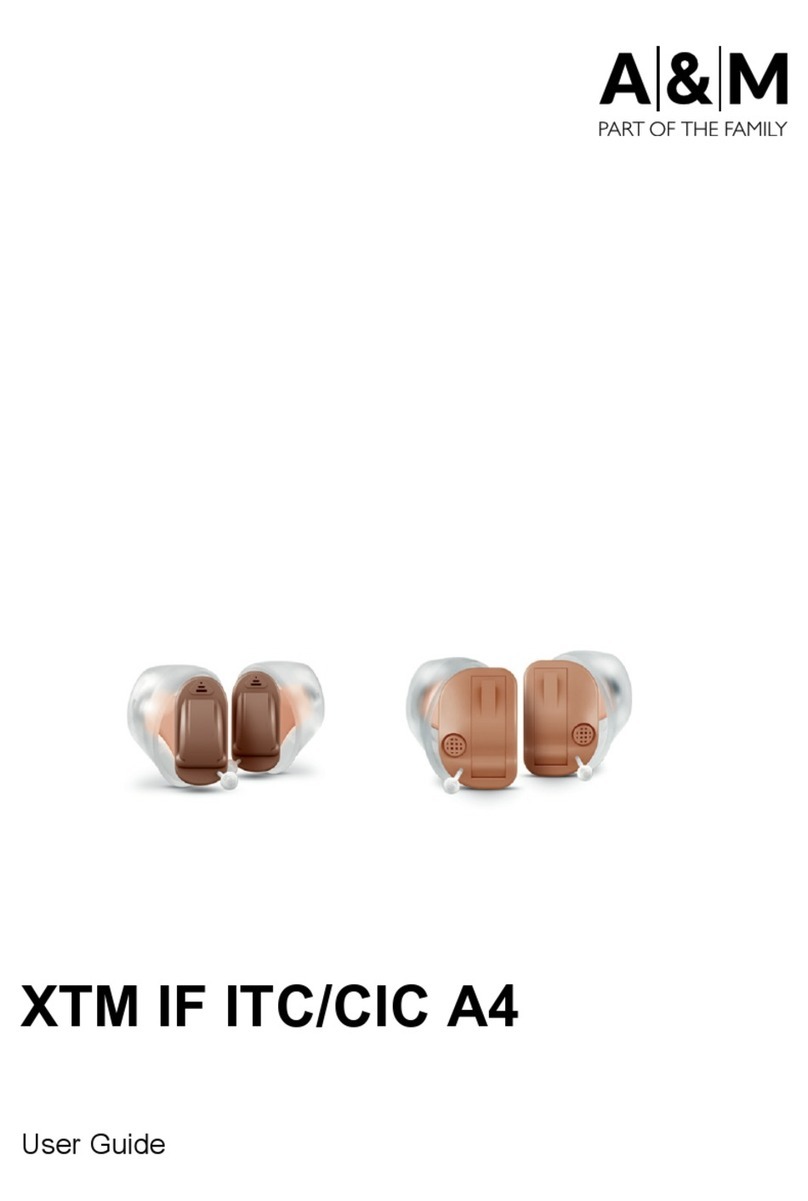Hearing Technologies Starkey 900sync User manual

November 16, 2020
Reference: Wireless Hearing Aid Data Security Statement
Dear Sir/Madam:
Starkey Hearing Technologies wireless hearing aids use one of three different frequency bands
and transmission protocols depending on the product. All technologies provide security;
however, each uses a different method for this purpose.
900sync Wireless Hearing Aids
Starkey Hearing Technologies wireless hearing aids that operate either in the 902 to 928 MHz
band or 863 to 865 MHz band use our 900sync technology. This technology utilizes a
proprietary transmission method not based on any published standard. The processing within
Starkey Hearing Technologies 900sync wireless hearing aids also uses proprietary digital
modulation that incorporates a data whitener based on a complex polynomial to scramble the
data. These two design approaches prevent other commercially available devices from readily
discovering, intercepting, interpreting, or injecting transmitted data, and effectively ensure
security of transmitted data. In addition, the low output power and antenna size limit the range
at which Starkey Hearing Technologies 900sync wireless hearing aid transmissions can be readily
received to approximately 15 meters. This provides a pragmatic limit to the ability to intercept
data transmitted wirelessly.
The reverse is also true. The Starkey Hearing Technologies 900sync wireless hearing aid family is
unable to transmit or receive data in any transmission protocol other than its own proprietary
transmission protocol. That, combined with the very limited range to which it can transmit,
effectively ensures that the Starkey Hearing Technologies 900sync wireless hearing aid family
cannot discover, intercept, interpret, or inject transmitted data associated with other devices.
900sync hearing aids can receive audio information from the SurfLink Media, SurfLink Mobile,
SurfLink Remote Microphone, and SurfLink Mini Mobile accessories using a Starkey proprietary
encoding method. The ability to receive audio from SurfLink accessories can be disabled on the
hearing aids. The range of these accessories is about 15 meters.
900 sync hearing aids can also receive audio information from the other hearing aid of a
binaural pair during a telephone call. This audio streaming only occurs when enabled by a
hearing aid button press to select a memory where this streaming is enabled or by a DC
magnetic field near the hearing aid, such as that from a telephone handset, which enables
streaming between the two hearing aids of the pair when the magnetic field is present.
900sync hearing aids can receive data commands from the SurfLink Remote and SurfLink Mobile
using a Starkey proprietary encoding method. These commands are used to control the basic
functionality of the hearing aids (change volume and memory settings). A SurfLink Remote or
SurfLink Mobile must be paired to a specific set of hearing aids. The hearing aids can transmit
data commands to each other, similar to the SurfLink Remote. These commands are used to
change volume and memory settings.

Wireless Hearing Aid Data Security Statement –page 2
When using the SurfLink Mobile or SurfLink Mini Mobile as a cell phone accessory, the hearing
aid microphones can be used to transmit the patient’s voice (JustTalk feature) during a phone
call. The JustTalk feature can be disabled on the SurfLink Mobile.
The SurfLink Media, SurfLink Mobile, SurfLink Remote Microphone, and SurfLink Mini Mobile
devices are the only Starkey accessory devices that can capture and wirelessly transmit audio
that can be successfully decoded by the hearing aids.
The SurfLink Programmer can detect the presence of a specific 900sync hearing aid within its
range (about 10 meters). The programmer could also change the programming of a 900 MHz
hearing aid within its range. The risk of program alteration can be mitigated by setting a hearing
aid lock code in Inspire when the hearing aid is initially programmed.
2.4 GHz Wireless Hearing Aids
Starkey Halo, Halo 2, Halo iQ, Livio, Livio AI, and Livio Edge AI hearing aids “2.4 GHz hearing aids”
operate in the 2.4 to 2.4835 GHz band and use a number of methods to provide secure
communications.
Bluetooth Security
2.4 GHz hearing aids communicate with the Starkey 2.4 GHz Programmer, and with Apple iOSTM
1
devices, (including the iPhone®
2
) and AndroidTM
3
mobile devices
4
that use the Thrive hearing
control application using the Bluetooth®
5
Low Energy protocol. In addition, the Starkey Hearing
Technologies Remote, Starkey Hearing Technologies TV, Remote Microphone+, Mini Remote
Microphone, and Table Microphone communicate with Halo iQ
6
, Livio, Livio AI, and Livio Edge AI
hearing aids using the Bluetooth Low Energy protocol to pair with the hearing aids and generate
the encryption key used for sending commands to the paired hearing aids. In today’s world,
because information is being transmitted, there are occasionally concerns about the security of
the information that is being sent.
The Bluetooth Low Energy protocol used in the 2.4 GHz hearing aids is very secure. From a
technically descriptive standpoint, that protocol is based on RFC 4493, which employs a cipher-
based message authentication code (CMAC) that uses the advanced encryption standard (AES-
128) as the block cipher function. In practical terms, this means that once two devices are
paired with each other, all information passed between the devices is encrypted and therefore
effectively undecipherable by any other device.
The lone security risk exists only during pairing. 2.4 GHz hearing aids use LE legacy pairing. This
1
iOS is a trademark or registered trademark of Cisco in the U.S. and other countries and is used under
license by Apple, Inc.
2
iPhone is a registered trademark of Apple, Inc.
3
Android is a trademark of Google, Inc.
4
The specific Apple iOS and Android devices supported by the Thrive Hearing Control app can be found on
the Starkey Hearing Technologies Smartphone Compatibility web page.
5
Bluetooth is a registered trademark of the Bluetooth Special Interest Group
6
The Starkey Hearing Technologies TV Remote Microphone+, Mini Remote Microphone, and Table
Microphone only operate with Livio, Livio AI, and Livio Edge AI hearing aids.

Wireless Hearing Aid Data Security Statement –page 3
is convenient for the patient but is vulnerable to eavesdropping or man in the middle attacks
during pairing
7
. During pairing, the devices each generate encryption keys and exchange them
with the other device. If keys are stolen, it is possible, but very difficult, to decipher information
sent from one device to the other. The probability of this occurring is remote for three reasons.
1) The equipment needed to acquire the keys is very specialized and expensive, 2) the range of
the transmission is limited to around 10 meters, and 3) Pairing is only required to be completed
once. An attacker would need to be present with said specialized equipment and in range at
this exact time to obtain the link keys. Subsequent connections thereafter will not have this
vulnerability and will be confidential. Therefore, it is highly unlikely that anyone would have the
equipment necessary and be in a position to steal the link key during pairing. However, if
security is a concern, it is suggested that while performing pairing a person do this in the privacy
of their own home or in another trusted place to ensure that your key is not stolen during this
process.
It is not possible to eavesdrop on audio streamed between the paired iPhone or Android phone
8
and the 2.4 GHz hearing aid by attempting to connect an intruder’s Bluetooth device to the
hearing aid, since the Bluetooth protocol used encrypts the audio stream on a per-link basis.
Note that audio is streamed from a paired iPhone or Android phone to a 2.4 GHz hearing aid.
Audio is only streamed from the hearing aid to a paired iPhone or Android phone when the
Personal Voice Assistant 2.0 feature
9
is used. This feature is triggered by a hearing aid user
control actuation and the stream lasts for up to 10 seconds to do voice recognition. The audio is
transported over an encrypted BLE link. If a user is concerned about security or privacy, they
can disable this feature using the mobile app. Also, the user can configure the feature to use
the local microphone on the phone rather than hearing aid microphone to capture the user’s
voice.
If the user’s iPhone or Android phone is off, its Bluetooth radio is off, or it is out of range when
the hearing aid is powered up, it is possible for an unwanted device to pair and thus connect to
the hearing aid. Note that a 180 second pairable timeout applies to all Bluetooth devices. After
180 seconds OR after a paired iOS/Android device is connected, a hearing aid will only accept
connections from BLE devices that are already paired. This is our primary mechanism for
mitigating a denial of service attack. If the unwanted device is able to connect to the hearing
aid, it can exercise the existing controls of the hearing aid and prevent the user’s own iPhone or
Android phone from connecting to the hearing aid. This would be detected by the user since
the hearing aid would no longer respond to the Thrive app on the user’s iPhone or Android
phone.
Therefore, a useful test to verify that no other Bluetooth device other than the user’s iPhone or
Android phone is connected to the 2.4 GHz hearing aid is for the user to attempt to connect
their iPhone or Android phone with the Thrive app to their hearing aids after hearing aid power-
up. If the connection attempt succeeds, no other Bluetooth device can connect to these hearing
aids as long as the hearing aids remain powered up, the iPhone or Android phone and its
7
Once pairing has occurred, then all future communications are encrypted.
8
Audio streaming from Android phones is only supported by Livio, Livio AI, and Livio Edge AI hearing aids.
9
This feature was introduced in February 2020 with the Sydney program.

Wireless Hearing Aid Data Security Statement –page 4
Bluetooth radio remains on, and the iPhone or Android phone remains within range of the
hearing aids.
The Starkey 2.4 GHz Wireless Programmer can detect the presence of a specific 2.4 GHz hearing
aid within the hearing aid range (about 10 meters). The programmer could also change the
programming of a 2.4 GHz hearing aid within its range (10 meters) that is not paired to a mobile
phone. The risk of program alteration can be mitigated by setting a hearing aid lock code in
Inspire when the hearing aid is initially programmed. If such a code is programmed, the code
must be entered before Inspire can read the hearing aid or change any of its programmed
settings. We also disable Undirected Connectable Mode on the hearing aid when connected to
a programmer. This prohibits other BLE connections from being established with the hearing
aids.
The Starkey Hearing Technologies Remote, Starkey Hearing Technologies TV, Remote
Microphone+, Mini Remote Microphone, or Table Microphone can detect the presence of a
specific Halo iQ, Livio, Livio AI, or Livio Edge AI hearing aid within the hearing aid range (about 10
meters). The accessory can pair to hearing aids under the following condition:
•Hearing aid is not connected to a mobile phone
•Hearing aid is in pairable mode (i.e. within 180 seconds after power-up)
•Hearing aid is within 1 meter of the accessory (we typically recommend 6 inches or
less when pairing with the RSSI filter).
10
The accessory can send commands to a paired hearing aid thereafter within its range (10
meters), regardless of whether a mobile phone is connected or not.
However, the commands can only act within the limits (for example, raising or lowering volume)
that have been previously programmed into the hearing aid by a hearing care professional.
Audio Broadcast Mode Security
The Livio, Livio AI, or Livio Edge AI hearing aids connect with the Starkey Hearing Technologies
TV streaming device, the Remote Microphone+, the Mini Remote Microphone, or Table
Microphone by using the Bluetooth Low Energy protocol to associate the hearing aid(s) with the
TV streamer, Remote Microphone+, Mini Remote Microphone, or Table Microphone. However,
no secure encrypted information is exchanged during this process. Once an association is
established, the TV streamer and/or Remote Microphone+ then communicates with the Livio,
Livio AI, or Livio Edge AI hearing aid(s) using a proprietary audio broadcast mode in which the
audio stream is not encrypted. Note that audio is only streamed from an associated TV
streamer, Remote Microphone+, Mini Remote Microphone, or Table Microphone to a Livio, Livio
AI, or Livio Edge AI hearing aid. No audio is ever streamed from the hearing aid to a TV
streamer, Remote Microphone+, Mini Remote Microphone, or Table Microphone.
Note that although the link between the Starkey Hearing Technologies Remote Microphone+
10
In addition, these accessories use an RSSI filter to limit the communication range during pairing. The
accessories don’t have a display for the user to select their device during pairing, so the RSSI filter
provides some level of discrimination so the correct hearing aids are paired. The RSSI filter is not used
when sending commands after the accessory is paired to the hearing aid(s).

Table of contents
